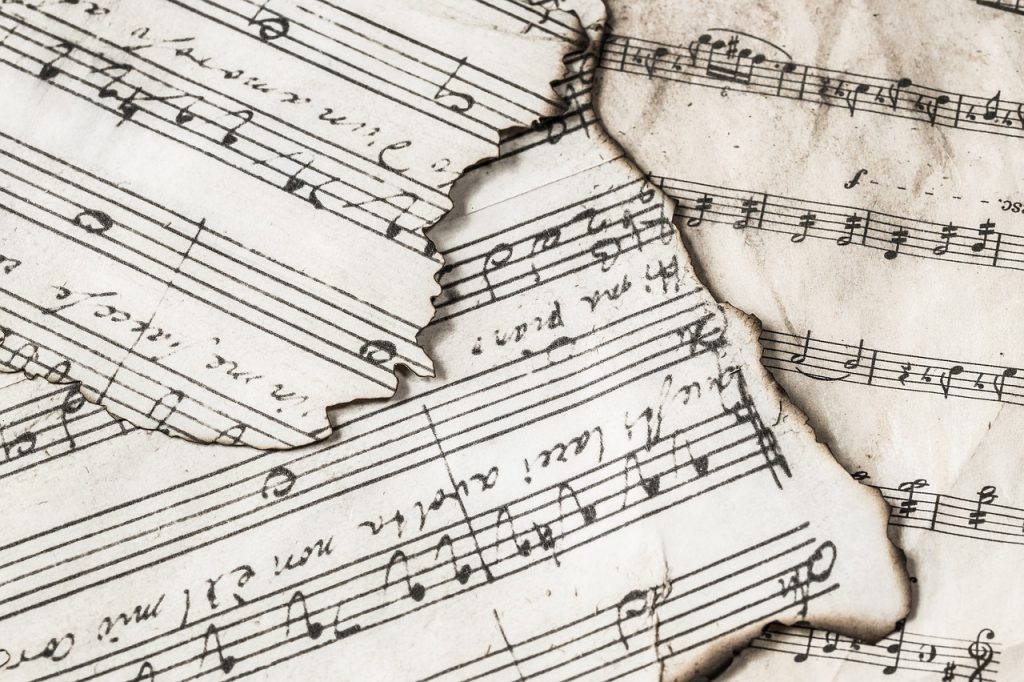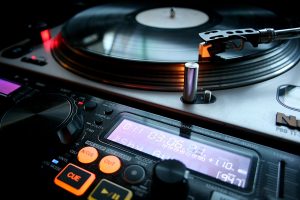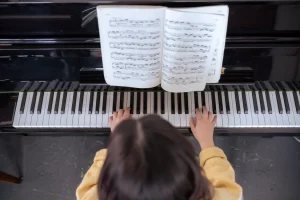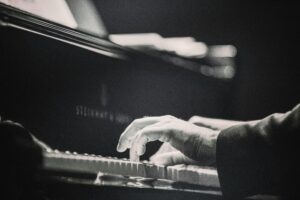Aleatoric music refers to the compositional approaches and general philosophy of music that emerged primarily in the 20th century. The concept focuses mainly on chance and indeterminacy in music, liberating performers to interpret and improvise on partially composed structures.
In this article, we delve into the origins, techniques, and significance of aleatoric music, shedding light on its defining characteristics and exploring notable examples that showcase its innovative spirit.
- Fall in love with the music - Learn your favorite songs, at a level suitable for you.
- Enjoy interactive piano lessons - Explore courses covering music theory, technique chords & more.
- Get real-time feedback - Skoove's feedback tells you what went well and what needs practice.

Origins and history of aleatoric music
Aleatoric music, often referred to as “chance music,” “indeterminate music,” or “random music,” defies traditional notions of composition by incorporating elements of unpredictability and randomness into the creative process.
Its roots can be traced back to the mid-20th century, a period marked by experimentation and a desire to break free from conventional musical constraints.
What is aleatoric music?
Aleatoric music incorporates elements of chance and uncertainty in music. This allows a certain amount of randomness to influence the shape or performance of a particular composition. This also means that no two performances of a single composition may be identical, no matter if the piano chords are all the same.
Logistically, aleatoric music manifests in various ways, including:
- Graphic notation
- Chance operations
- Open-form structures
This differs from traditional music notation of the preceding centuries, where every note and dynamic is meticulously organized and notated. This video provides a visual representation of aleatoric music, showcasing how the element of chance defines this type of music.
Historical context and early aleatoric music examples
In Europe and America, aleatoric music emerged from the broader cultural movements in the mid-20th century. The rise of the various avant-garde art and music movements influenced several composers to explore new avenues.
As aleatoric music gained traction in the mid-20th century, it sparked a wave of experimentation and innovation, inspiring composers to explore new avenues of expression and challenge traditional musical conventions
Notable composers and their contributions
Throughout history, several composers have made significant contributions to developing aleatoric music.
As highlighted by music professionals in the Quora thread mentioned above, there are varied discussions on the key examples of aleatoric music, including John Cage. Some of the earliest examples of aleatoric music can be found in the compositions of Cage, including “Music of Changes” and “4’33””.
The German composer, Karlheinz Stockhausen, a leading figure in the avant-garde movement, experimented with aleatoric techniques in works such as “Klavierstück XI” and “Momente.” Similarly, Pierre Boulez’s “Third Piano Sonata” and Witold Lutosławski’s “String Quartet” exemplify the innovative use of chance elements in composition.
Types and techniques of aleatoric music
Aleatoric music incorporates a range of techniques and approaches. Let’s explore some classifications and common techniques composers have used as well as some examples..
Classification of aleatoric music
Aleatoric music can be classified into various categories based on the degree of control the composer exerts over the final outcome. These categories include:
- Fully aleatoric
- Partially aleatoric
- Controlled aleatoric music
Fully aleatoric music relinquishes complete control to chance, while partially aleatoric compositions combine elements of chance with predetermined structures. Controlled aleatoric music maintains a balance between chance and composer input, allowing for a degree of control over specific parameters, like piano scales, dynamics, or harmonies.
Common techniques used in aleatoric compositions
Let’s explore some of the common compositional techniques in aleatoric music.
Graphic notation
Graphic notation employs visual symbols, shapes, and diagrams to represent musical elements, offering performers greater interpretative freedom and flexibility.
Composers such as Earle Brown and George Crumb utilized graphic notation to create evocative and visually striking scores that invite performers to engage with the music in unconventional ways. These scores are often works of art in and of themselves.
Chance operations
Chance operations involve the use of random processes or algorithms to determine musical elements such as pitches, rhythms, and dynamics.
John Cage’s “Music of Changes” employs the I Ching, an ancient Chinese divination text, to determine musical parameters, resulting in a composition characterized by its aleatoric nature and unpredictable sonic textures.
Open form structures
Open-form structures allow for non-linear or flexible arrangements of musical material, allowing performers to interpret and shape the performance in real time with full control of the modulations in music.
Morton Feldman’s “Crippled Symmetry” exemplifies this approach, featuring modular sections that can be rearranged or performed independently, resulting in a dynamic and ever-evolving sonic landscape.
Indeterminate notation
Indeterminate notation provides ambiguous or incomplete instructions to performers, allowing for multiple interpretations and improvisational responses.
Karlheinz Stockhausen’s “Klavierstück XI” utilizes indeterminate notation to create a sense of spontaneity and exploration, inviting performers to actively engage with the composition and shape its sonic trajectory.
The philosophy and aesthetics of aleatoric music
Aleatoric music likewise includes a profound philosophical underpinning, detailing complex conceptions of the nature of creativity and the role of chance and improvisation in music composition and performance. Let’s briefly touch on the aesthetic and philosophical underpinnings of aleatoric music and its implications for the relationship between composer, performer, and audience.
Aleatoric music challenges the traditional notion of the composer as the sole author of a work, instead embracing uncertainty and the potential for multiple outcomes, as determined by the performers in the moment. The performer becomes a co-creator, bringing their interpretation and decision-making to the forefront, thus reshaping the audience’s experience with each performance. Unlike conventional composition, which dictates precise instructions for performance, aleatoric music often provides a rough framework or guide within which performers exercise a degree of autonomy, resulting in a dynamic and ever-evolving piece.
Through these explorations, aleatoric music not only expands the boundaries of musical composition but also invites us to reconsider the essence of art itself. It is a testament to the beauty of unpredictability and the shared human experience of creation and interpretation.
Impact and reception of aleatoric music
Aleatoric music has had an important impact on contemporary music for both composers and performers in a range of genres and styles. While most of the music is quite difficult to play, it is worth exploring as you learn how to play piano.
Influence on contemporary music
Aleatoric music and the emphasis on spontaneity, improvisation, and collaboration have permeated various genres and styles, from avant-garde experimentation to popular music and film scoring. Composers across diverse musical traditions have embraced aleatoric techniques, leading to the emergence of hybrid forms and cross-disciplinary collaborations.
Reception among audiences and critics
The reception of aleatoric music among audiences and critics has been varied, reflecting both fascination and skepticism towards its unconventional approach to composition and performance.
While some listeners are drawn to the sense of freedom and unpredictability inherent in aleatoric music, others may find its emphasis on chance and randomness disconcerting or inaccessible. Critics have praised aleatoric music for its bold experimentation and boundary-pushing ethos, recognizing its role in expanding the possibilities of musical expression and challenging established norms.
However, aleatoric music has also faced criticism for its perceived lack of structure and coherence, with some questioning the artistic validity of compositions that rely heavily on chance and indeterminacy.
Leaving it up to chance
Aleatoric music is a challenging philosophical idea and has produced some music that many people might find distasteful. However, as a creative approach and compositional technique, aleatoric music leaves the door open for beautiful and spontaneous creative moments.
As we look to the future, platforms like Skoove are pivotal in the development of music skills, offering tools that bridge the gap between traditional learning and modern experimentation.
Through such innovations, aleatoric music will undoubtedly continue to inspire, challenge, and evolve, resonating with those who seek to experience the full spectrum of musical expression and deepen their artistic and compositional skills.
Author of this blog post:
Susana Pérez Posada

With over seven years of piano education and a deep passion for music therapy, Susana brings a unique blend of expertise to Skoove. A graduate in Music Therapy from SRH Hochschule Heidelberg and an experienced classical pianist from Universidad EAFIT, she infuses her teaching with a holistic approach that transcends traditional piano lessons. Susana’s writings for Skoove combine her rich musical knowledge with engaging storytelling, enriching the learning experience for pianists of all levels. Away from the piano, she loves exploring new places and immersing herself in a good book, believing these diverse experiences enhance her creative teaching style.
Published by Lydia Hovan from the Skoove team














